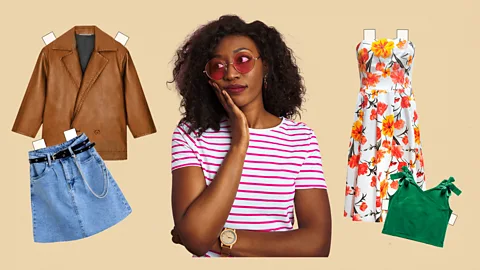Why do we dress like someone else when we go on holiday?
 Yun Sun Park/ Getty Images
Yun Sun Park/ Getty ImagesWhy do we dress like someone else when we go on holiday? From multipurpose utility garments to Instagrammable maxi dresses and floppy hats, one thing is for sure – we don't dress this way at home.
An American friend recently asked me what to wear on her first flight to Europe. "I want to be comfy but chic," she said. She'd come to the wrong person. As a travel journalist, I'm either on assignment, sun cream-smeared in hiking boots and hauling a rucksack like a tortoise shell; or travelling light with a five-piece capsule wardrobe in beige neutrals to leave space for edible souvenirs.
Meanwhile, many of my fellow travellers parade past in floral gowns, breezy summer whites or cosy pyjama-like layers. Sometimes I glimpse my own reflection and feel a pang of FOMO. Should I have worn a floral dress to photograph ruins? I don't even own one. Or perhaps instead of clunky hiking boots, I would be more comfortable in a pair of Birkenstocks, with thick white socks hiked up to my knees.
As disparate and sometimes dramatic as travel get-ups can be, one thing is for sure: we don't dress this way back home.
 Getty Images
Getty ImagesThe dawn of holiday wear
So why do we dress so differently when we're on holiday – almost as if we're someone else?
Marta schini, head of communications and editorials at the European Fashion Heritage Association, says that the holiday wardrobe emerged alongside leisure travel in the 19th Century. "Prior to this, clothing for travel was primarily utilitarian, associated with migration, pilgrimage or military and trade expeditions," she explained. According to schini, the growth of the middle class and the expansion of railways in Europe in the mid-1800s meant that seaside resorts became fashionable destinations, prompting the development of travel wardrobes that fused elegance with comfort. Warm weather necessitated lighter, breathable fabrics such as linen and silk, and by the interwar period, designers like Coco Chanel were championing relaxed styles such as casual knitwear, wide-leg tros and swimwear.
"The post-World War Two economic boom, coupled with the advent of commercial aviation, democratised travel further," schini added. "From the 1950s to the '70s, leisurewear evolved into a distinct genre: Capri pants, resort prints, kaftans and cruise collections became staples."
schini also notes that the need to dress for unfamiliar temperatures "[permits] a certain relaxation of social dress codes".
That explains sandals with socks.
 Alamy
AlamyBackpacks and backlash
And yet, it is a universally acknowledged truth that no one wants to look like a tourist.
Lifestyle publications teem with articles steering travellers away from the reviled traditional tourist kit – T-shirt, backpack and hat – proposing, instead, luggage-conscious capsule wardrobes inspired by the destination itself. When Vanessa Friedman, chief fashion critic at the New York Times, receives reader questions about how not to look like a tourist on holiday, she taps locals for their input to make her recommendations. "I think people dress to belong," she told the BBC. "So, when you're travelling, you don't want to stand out."
But if the term "tourist" conveys a sense of escape from the everyday, what's so terrible about looking like one?
"There are some interesting negative connotations about being a tourist," said Dr Charlotte Russell, founder of The Travel Psychologist. "Ideas around being seen as naïve, not being experienced or well-travelled, perhaps clumsy with regard to cultural differences and potentially falling prey to unfair pricing. None of us want to be any of these things, so it's unsurprising that people want to differentiate themselves from these stereotypes."
schini believes that this wariness likely emerged in the late 20th Century, "as global travel became more accessible and distinctions between the traveller and the tourist became increasingly codified".
Anyone booking travel back then – the dawn of internet travel planning and the expat blog boom – would have witnessed that ever-growing chasm between the two. The smug verdict: tourists, who visit a place for mere days, are less culturally savvy than travellers, who may be privileged enough to spend months or even years overseas.
Dr Andrew Stevenson, author of the book The Psychology of Travel, believes this dichotomy reveals something deeper: how we want to be seen.
"Do you want to present yourself as somebody who's trying to blend in, like an anthropologist">window._taboola = window._taboola || []; _taboola.push({ mode: 'alternating-thumbnails-a', container: 'taboola-below-article', placement: 'Below Article', target_type: 'mix' });
